March 1996. That’s the last time Cremonese won a game in the top flight of Italian football.
Luigi Simons’ side travelled to Veneto in Northern Italy and came away with all three points against fellow strugglers Padova on that glistening spring afternoon.
The victory was the club’s second on the trot, having put Lazio to the sword a week prior. Fans were starting to believe in a turnaround. After a tumultuous start to the campaign, Cremonese were desperate to hang on to their Serie A status. This win could help do just that.
Unfortunately, it didn’t. If you’d have told the Cremona faithful that day that this would be the last time the Grigiorossi would be seen in the top tier for 26 years, there was a high chance you would have been slapped in the face.
Putting this into context, 26 years was the exact length of Sir Alex Ferguson’s reign at Manchester United.
Last season, Cremonese surprised the nation with a beautiful rise to prominence under Fabio Pecchia, the former assistant to Rafa Benítez at Real Madrid, Napoli and Newcastle United.
Pecchia guided Cremonese back to Serie A with a second-place finish in the league below. However, he unexpectedly resigned from his position to take up the head coach role at Parma in what many would describe as a backwards move given that the latter were still ravaging around in the depths of Serie B.
Massimiliano Alvini replaced Pecchia, a man who had no prior experience coaching in the promised land. Sadly for Alvini, his time ended with a zero percent win rate at Stadio Giovanni Zini.
Alvini’s replacement was at least a coach with some top-flight experience, having managed Lazio, Cagliari and Genoa beforehand.
Ballardini has done a better job than his predecessor, miraculously guiding Cremonese to a Coppa Italia semi-final, which the club have a chance of winning, having knocked out league leaders Napoli and European champions AS Roma in earlier rounds.
Nevertheless, Ballardini still hasn’t been able to grind out three points from his side who sit rock bottom of Serie A. This tactical analysis piece explores Cremonese’s struggles even further.
It will be an analysis, in the form of a team scout report, of the side to see which area of their tactics things have gone so desperately wrong this season.
Formations and style
Being a disciple of Benítez, Fabio Pecchia achieved great success last season using a highly pragmatic 4-2-3-1, one where possession was not the focus of the side’s style, unlike a lot of coaches in the modern game.
The team were quite direct and averaged just 3.05 passes per possession, showing a willingness to get the ball forward as quickly as possible, even if it meant going long to the forward line.
The Lombardy-based club averaged 48.6 percent of the ball throughout the 2021/22 promotion campaign in Serie B which was the seventh-lowest in the division. Yet, Cremonese finished second, proving that you don’t need to be a possession-oriented side to be successful.
Nonetheless, the team’s style this time around has shied away from last season’s blueprint. The 3-4-1-2 has been Cremonese’s primary formation in their frail attempt to survive the drop.
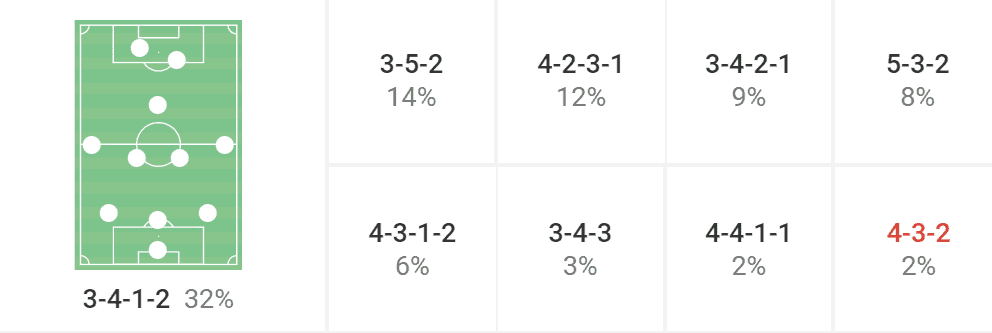
The 3-4-1-2 has been followed closely by its cousin, the 3-5-2 while the 4-2-3-1 still holds a place in Cremonese’s heart. There have also been a plethora of other structures used by the Italian minnows.
When teams chop and change their formations throughout a season, it is normally a tell-tale sign that they are struggling for results as the coaches panic to find the right system to deploy on the pitch.
Cremonese still haven’t found the right formation – and it seems that there isn’t one. No positional quantification can compensate for a lack of quality.
Interestingly, though, the Grigiorossi are performing really well in most metrics compared to the rest of the league, particularly in attack.
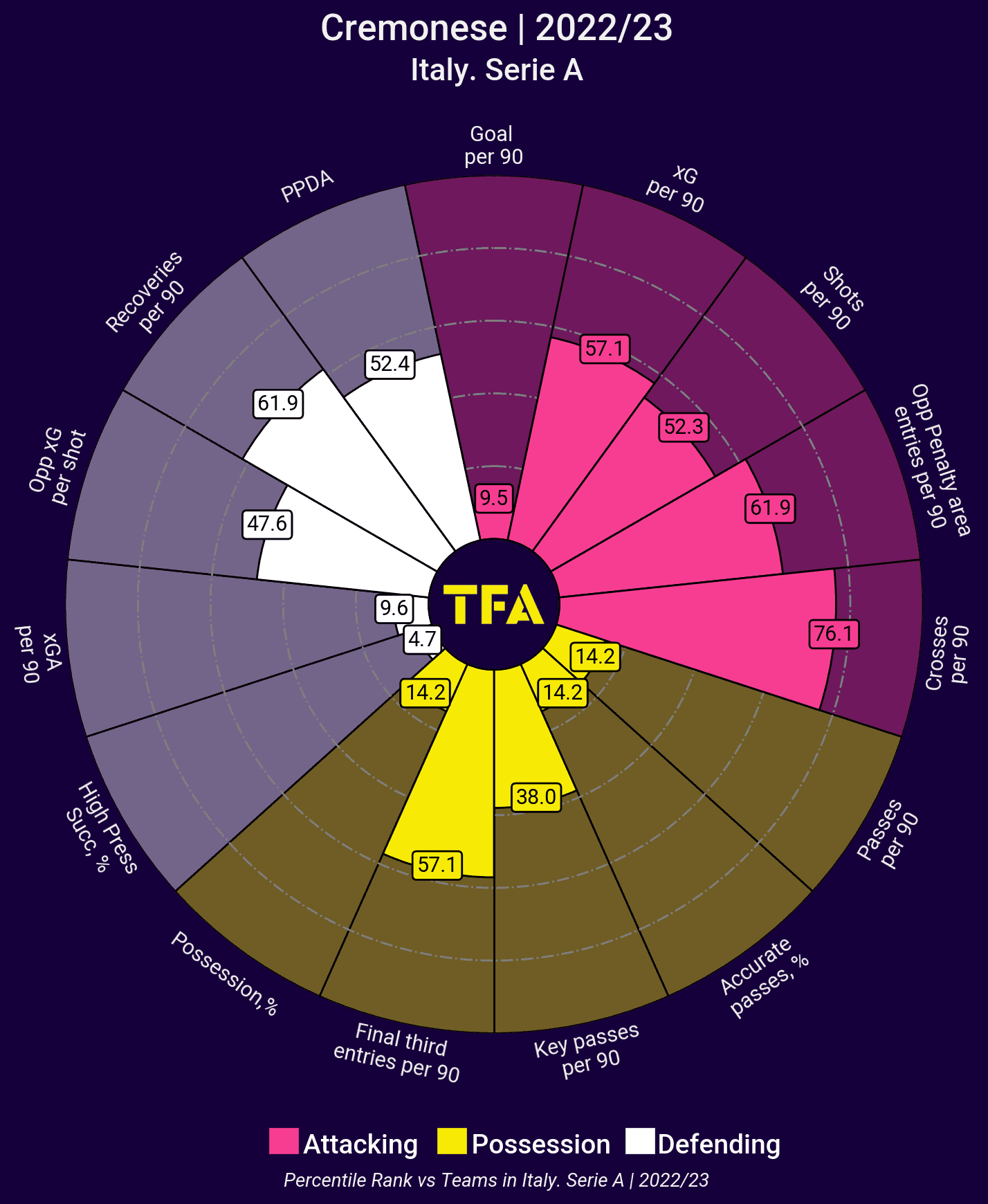
Cremonese are above the league’s median for xG, shots, opposition penalty area entries, final third entries and crosses per 90. However, they are performing incredibly low in terms of actual goals per 90, showcasing a worrying lack of quality in front of goal.
Possession has dropped to around 44 percent, but this was expected given the step-up in quality of Serie A from Serie B, yet Cremonese’s average passes per possession are up to 3.4 from last season’s 3.05.
Defensively, it’s another issue. Cremonese are really low in most metrics out of possession, causing Ballardini’s men to have the second-worst defensive record in Serie A with 40 goals conceded. Only Salernitana have conceded more, and not by much either.
Regardless, it’s important to note that when all these metrics are weighed up, Cremonese, in theory, should be higher up the table than they are. The team boasts 20.3 expected points which would put them third from bottom in comparison to the rest of the league in this metric.
However, if we take only Cremonese’s numbers, they would be 17th and out of the relegation zone.
But why is there such an underperformance by the collective? Let’s dive further into the team’s tactical and qualitative problems.
Goalscoring woes
Certainly not the most glaring issue that Ballardini has to deal with at the moment in time, but Cremonese are struggling in front of goal.
The Grigiorossi have scored merely 15 goals in Serie A this season which is the second-lowest in the division. Somehow, Sampdoria have actually bagged fewer but are sitting above Cremonese by three points.
Potentially the starkest data to analyse to see Cremonese’s underperformance in front of goal is their xG map.
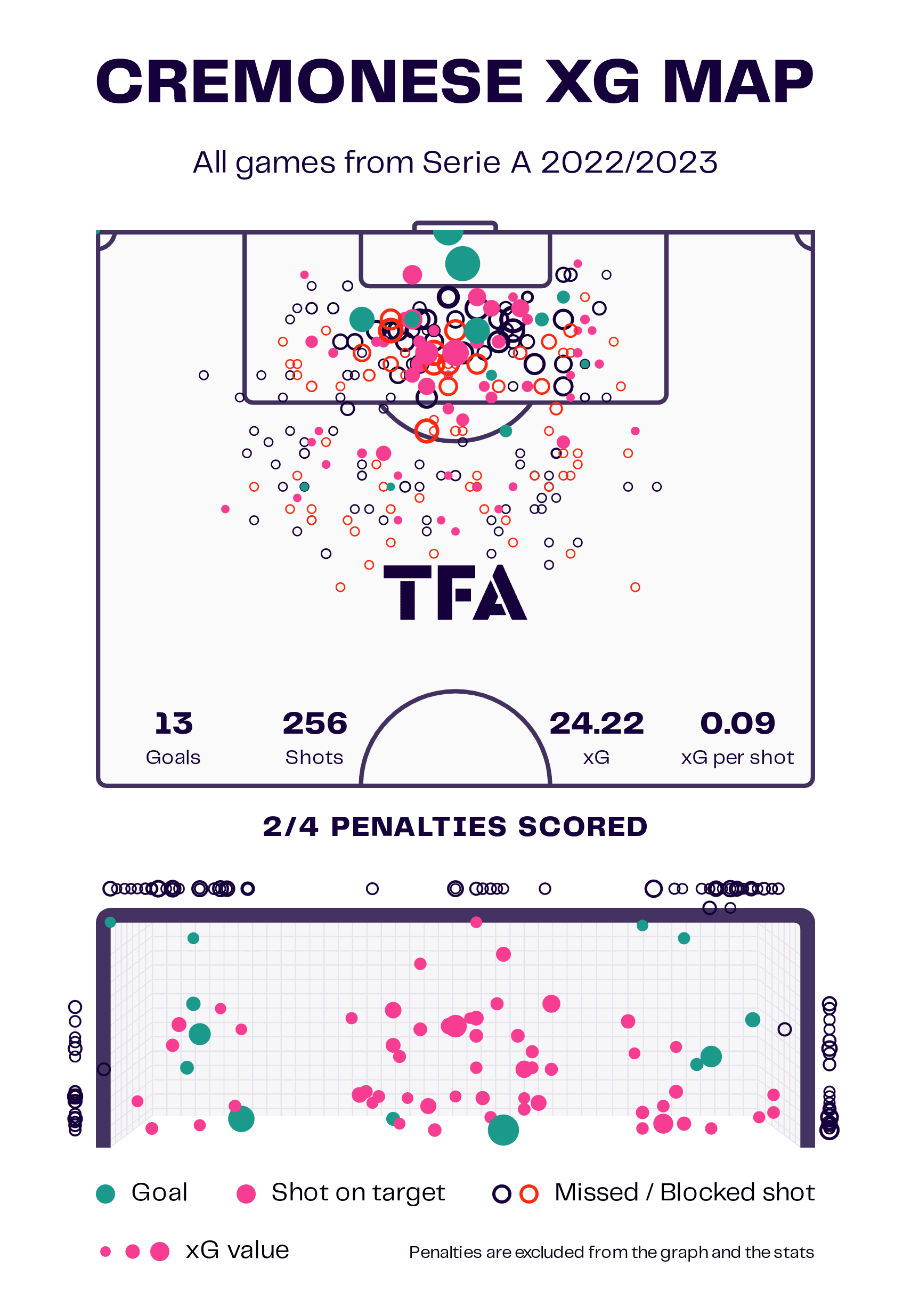
The Cremona club have scored merely 13 non-penalty goals from a non-penalty xG of 24.22. There are a few more things to analyse within this data viz.
Firstly, Cremonese’s average xG per shot rate currently stands at 0.09 which is extremely low. Per shot, there is roughly a nine percent chance that it hits the back of the net every time which is far from ideal.
This highlights the fact that Cremonese are not getting into good enough shooting positions in the final third to pose any sort of meaningful threat against the opposition’s goalkeeper. One of the main contributors to this is how many long-range opportunities the players take. Long shots are notoriously low percentage chances, so taking such a high volume of shots outside the area will always bring the average value down.
In the age of data, long shots are becoming a thing of the past. Chances outside the area are either a scarce phenomenon or are a product of desperation. Cremonese may fall into the latter category.
But is it merely a case of lacklustre finishing or is there also a lack of food coming out of the kitchen?
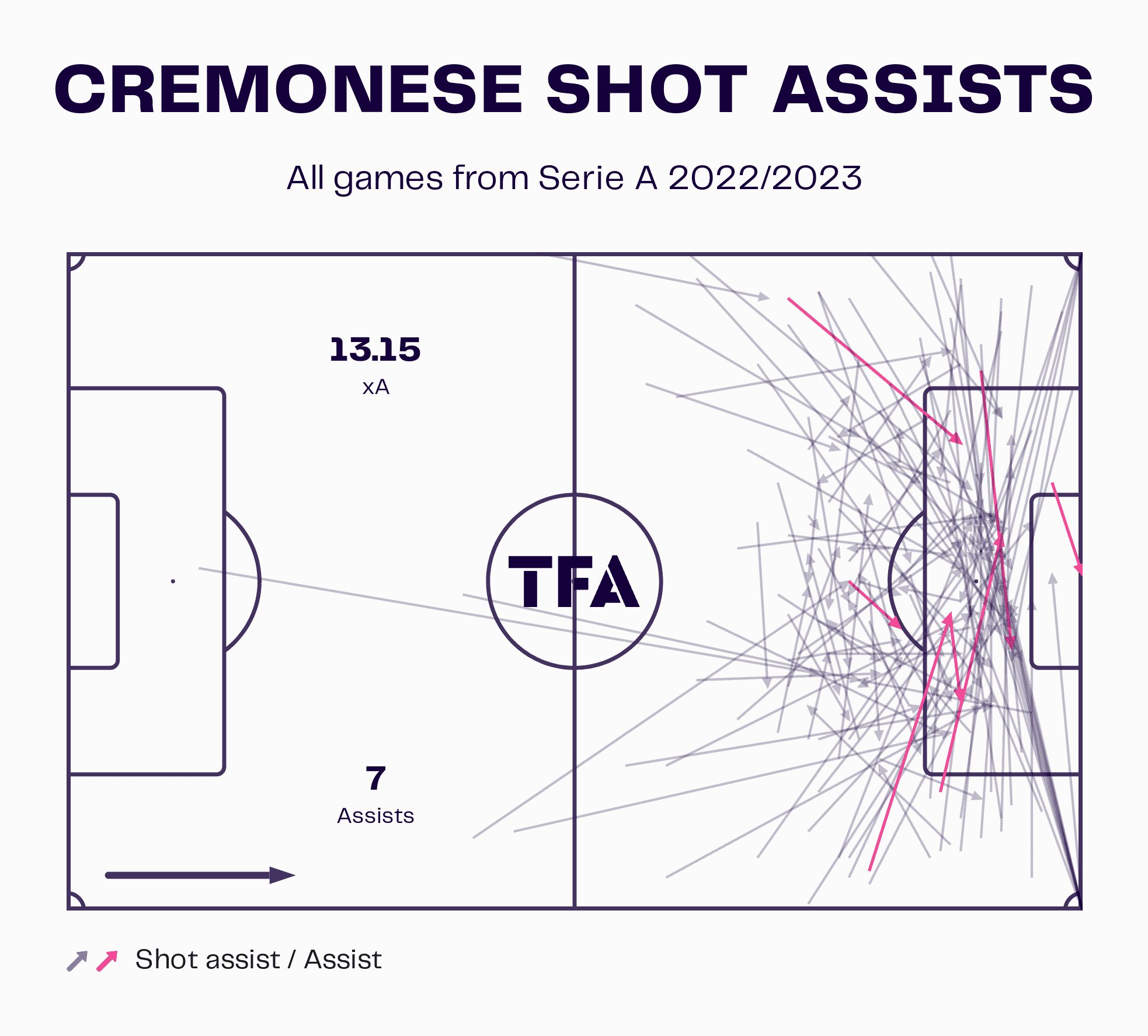
Cremonese’s shot assists map indicates that it’s simply a matter of inadequate potency from those tasked with putting the ball past the opposition’s goalkeeper. Seven real-time assists from an expected assists (xA) tally of 13.15 is the kind of underperformance that gets Darwin Núñez out of bed every morning.
However, it must be said that each shot assist is a direct result of a pass being made which leads to a shot towards goal. Since Cremonese take such a high quantity of shots from outside the area, this would certainly play its part in the xA being higher.
From the shot assists map, it is also evident that Cremonese create a lot of chances from the wide areas. Ballardini wants his attacking line to have an extra man against the opponent’s defence or to match them man-for-man, allowing for numerous 1v1 duels where the quality of the players will be the deciding factor.

In this example against Bologna from a recent 1-1 draw, Cremonese had a plus-one against the home team’s back four, which could also be labelled as numerical superiority. Three players were positioned on the inside channels while two were on the outside to create the 5v4. This makes attacking the box much easier and more likely to end in a goal because Ballardini’s side has an extra man.
Unfortunately, having an extra player can be increasingly difficult to concoct nowadays due to complex defensive systems that mean players can step up and drop off to create different formations within the base structure.
For example, if a team defends in a 4-5-1 and one winger drops into the backline to help add an extra man in case of an overload, the formation temporarily switches to a 5-4-1. This happens quite a lot to Cremonese in their hunt for numerical superiority of the last line. What ends up happening is that the opponents take their chances defending 1v1 because of a belief that Cremonese don’t really ever have superior quality up top.
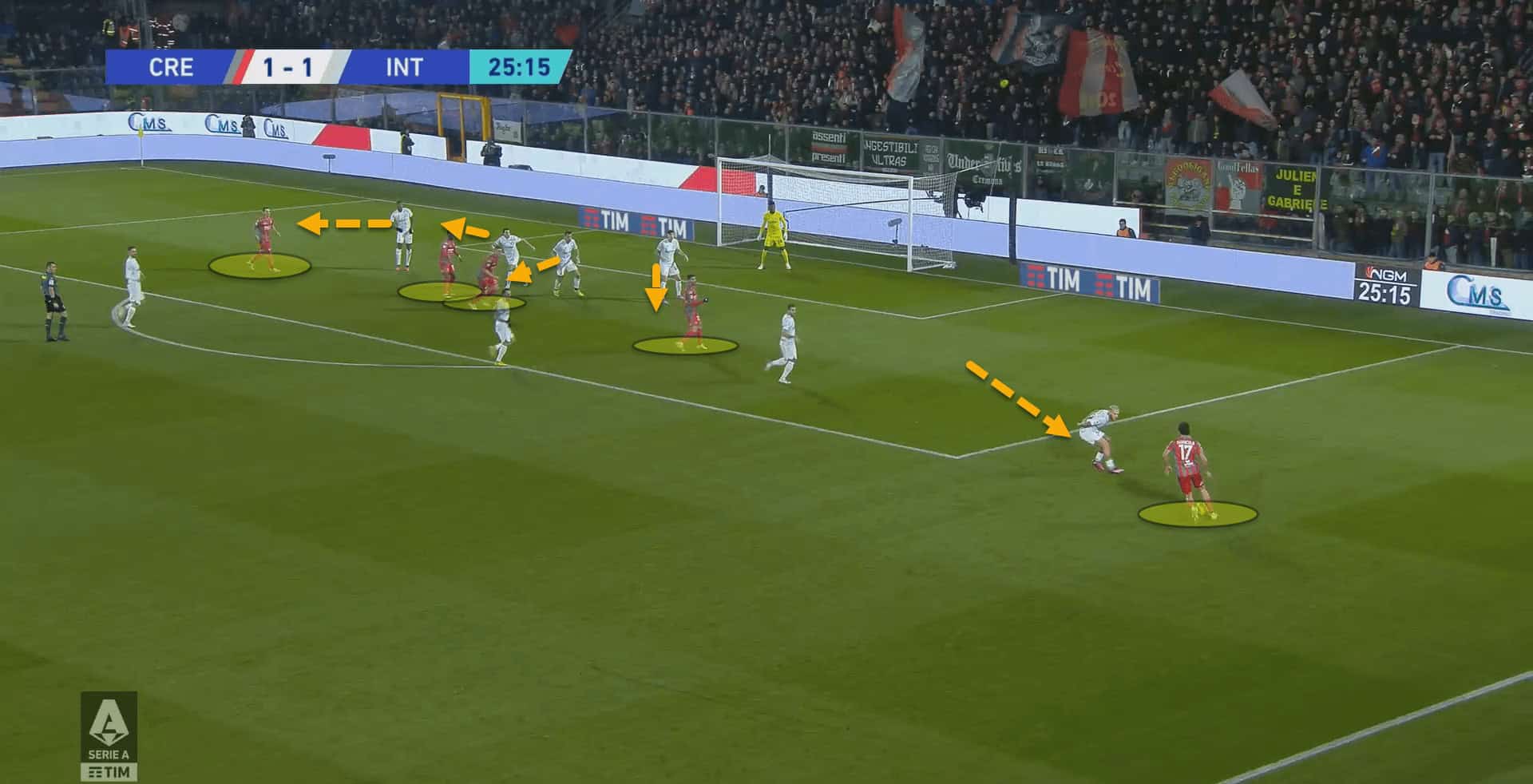
Here, Cremonese have piled four players into the penalty area. Internazionale have opted to defend their box by going man for man in a 4v4 situation while the wingback pushes across to defend the cross.
In these 1v1 scenarios, it’s a simple manner of the attacker facing the defender in a battle of quality. Unfortunately, in a battle of quality, Cremonese’s attackers fall short of most defenders in Serie A.
Defending is an art
Defending has been one of the most important aspects of football since its foundation. However, Italy is where defending was perfected and revered the most by viewers. Defenders such as Franco Baresi and Paolo Maldini are held in the same regard by Rossoneri fans as Alan Shearer is for Newcastle United.
Sadly, Cremonese’s defending this season has been somewhat blasphemous to some of these titans of Italian football.
Systematically, there are some issues. However, there is way more work needed on the fundamentals of defending as a unit for Le Tigri. It may not be very tactical, but individual errors have led to far too many breakdowns of their defensive block this season, causing atrocious goals to be conceded.
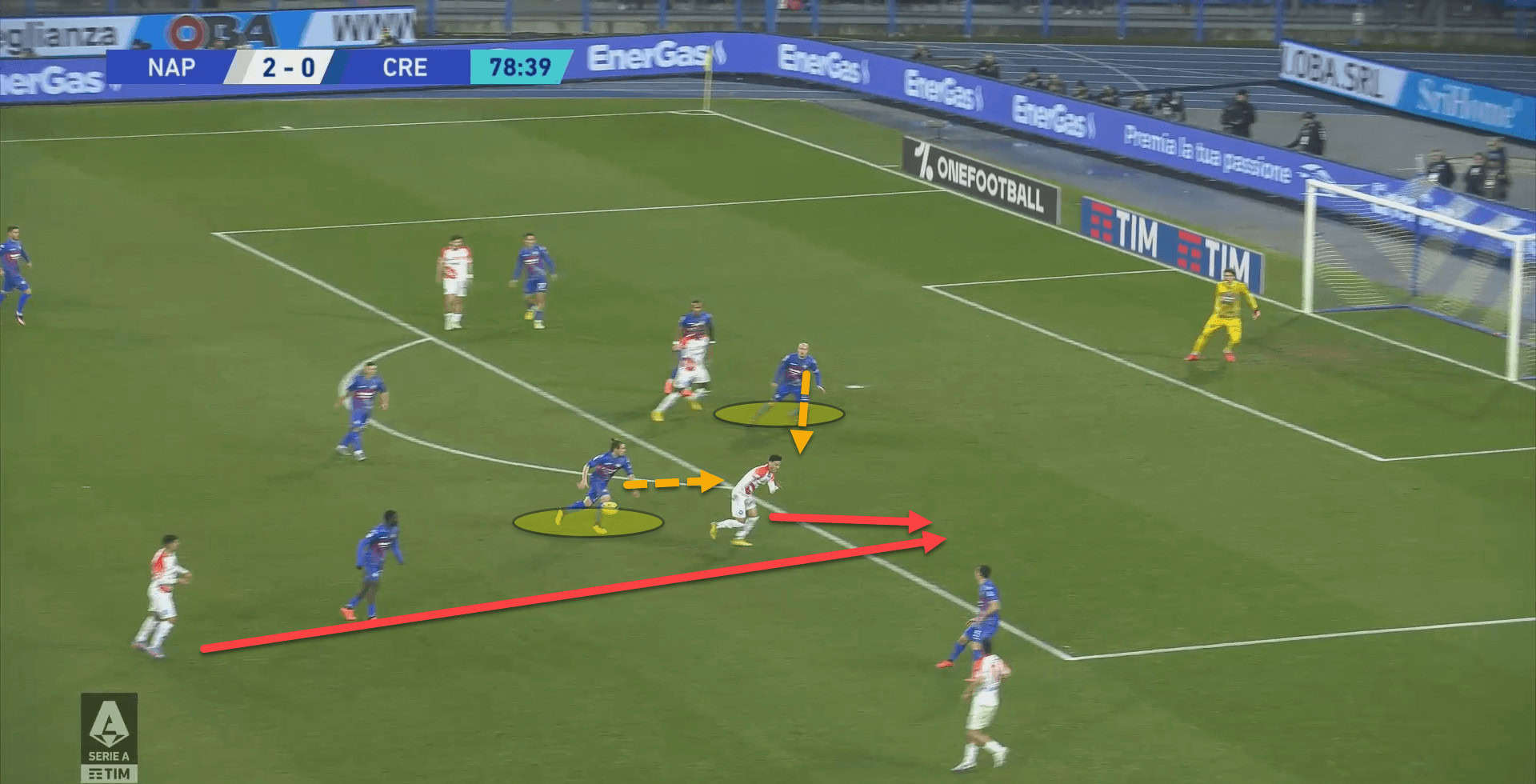
Here is just one example of some grimacing individual errors while defending inside a block. Cremonese are not outnumbered at the back. They have enough players in and around the box to either go man-for-man or to have an extra body.
Elif Elmas made a run into the space between the wingback and centre-back since the former had been dragged out wide to defend. Both the centre-back and the holding midfielder are free to pick up the North Macedonian to prevent him from getting a free shot away in the box. Neither reacts. 3-0 Napoli.
It’s really not ideal for players to lack such focus when playing against high-class sides such as Napoli who can be absolutely devastating. Defenders make too many individual errors for it to matter about the formation that Cremonese are using.
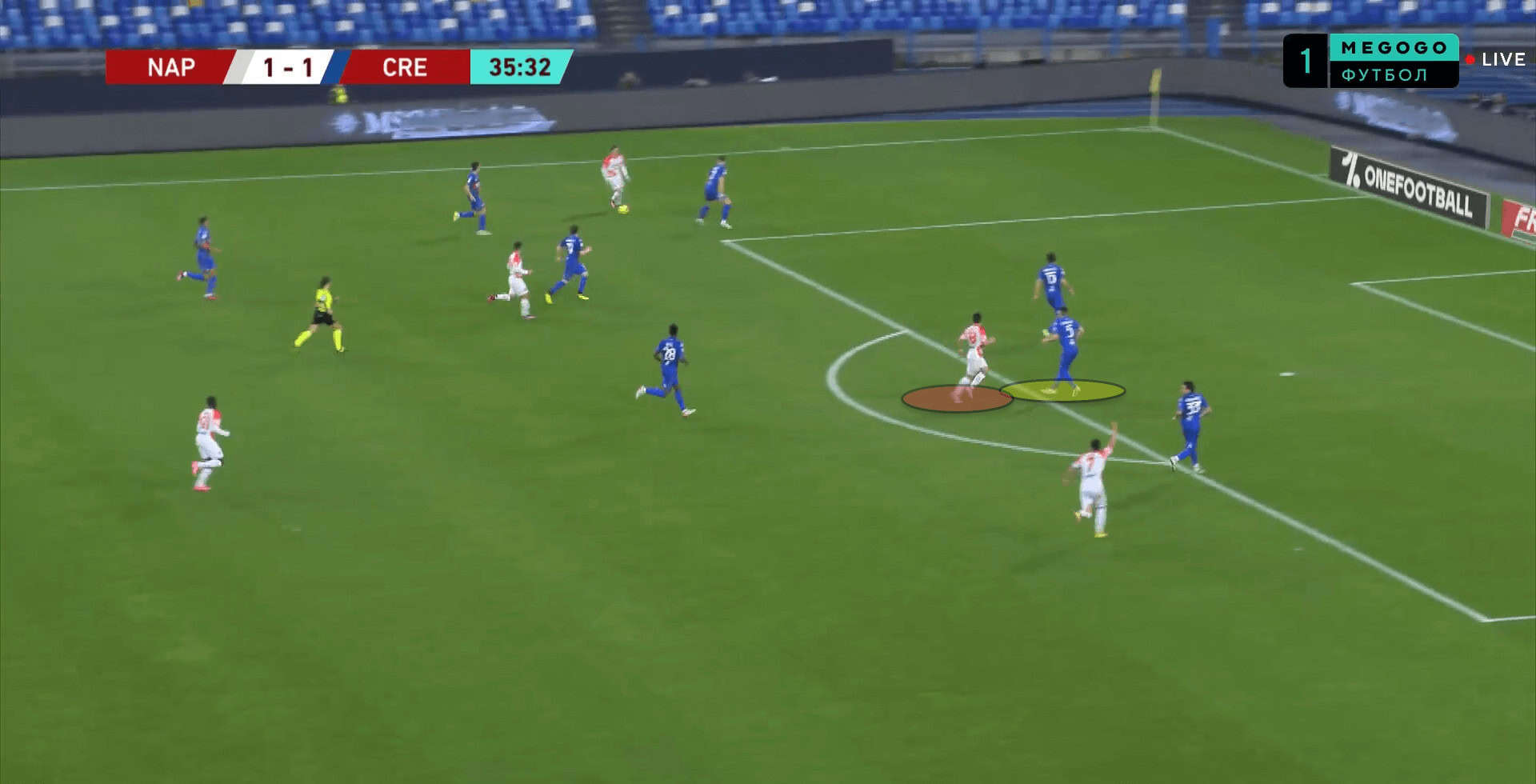
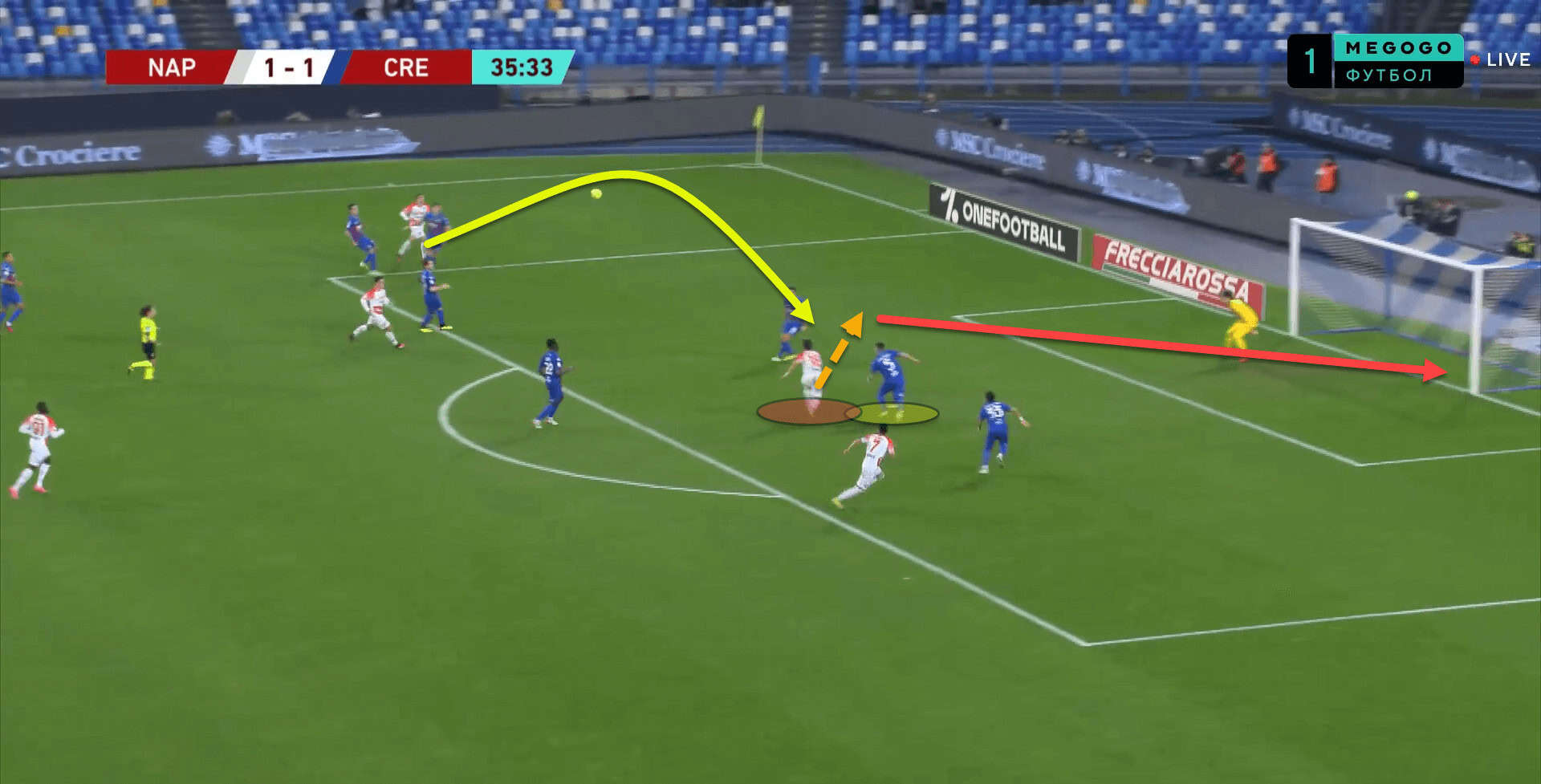
This is another prime example of some really poor individual defending from Cremonese. The defender begins in a subpar stance, facing the forward with his back to goal instead of defending side-on which would allow him to set himself to both drop deep and step forward depending on what the situation called for.
As a result of his deficient initial stance, the Napoli frontman makes a run on the inside and the Cremonese centre-back can’t get anywhere near him because his body orientation was suboptimal to begin with. The header breezed past the goalkeeper and the Azzurri took the lead, but it was abhorrently avoidable.
Ballardini’s men have conceded the second-highest number of goals in Serie A this season and so it’s certainly not a surprise that they are bottom of the league. Furthermore, this woeful defensive record has hindered them in holding on to leads which has become a problem area for the minnows.
Overall, Cremonese have dropped 10 points from winning positions in Italy’s top-tier this season. This is far from ideal for a team who can’t buy a win at the moment.
But it’s not just a case of exasperating individual errors that has Cremonese in a pit of despair. Of course, this doesn’t help. However, the lack of compactness from the team in and around the penalty area is inexplicably frustrating.
I Grigiorossi primarily defend in a mid-to-low block. There are very few defensive actions highlighted in the final third showing an unwillingness to press too high up the pitch.
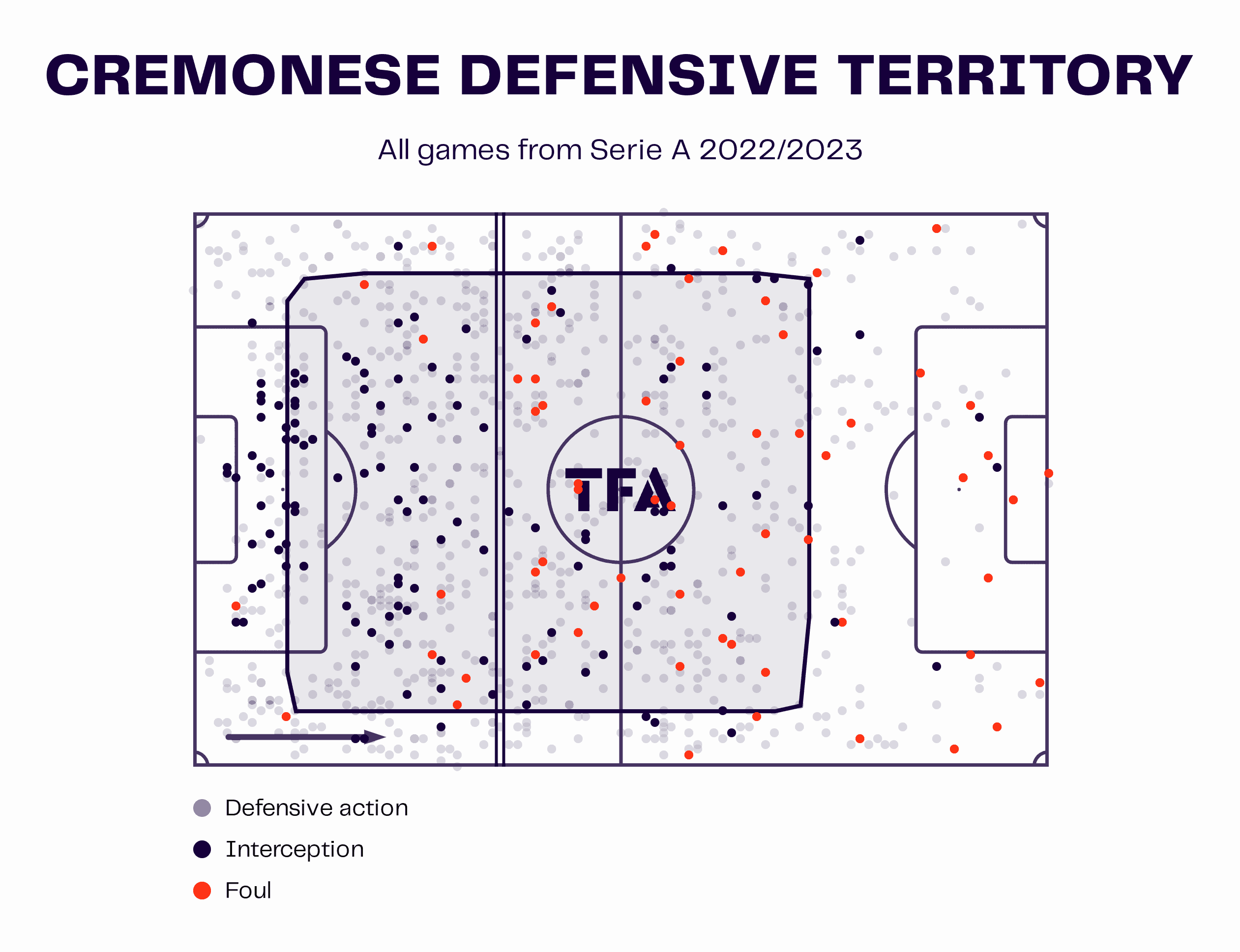
Most of the actions from the team out of possession come in the middle and final third which means that it is these areas where the team defend the most in a defensive block.
Regardless of whether Ballardini deploys a 3-4-1-2 or a 3-5-2, Cremonese’s structure reverts into a 5-3-2 when defending in their own half of the pitch. In theory, the objective is to close off the centre of the park to force the opposition wide, but this seems like a much more difficult task for the Lombardy club than it should be.
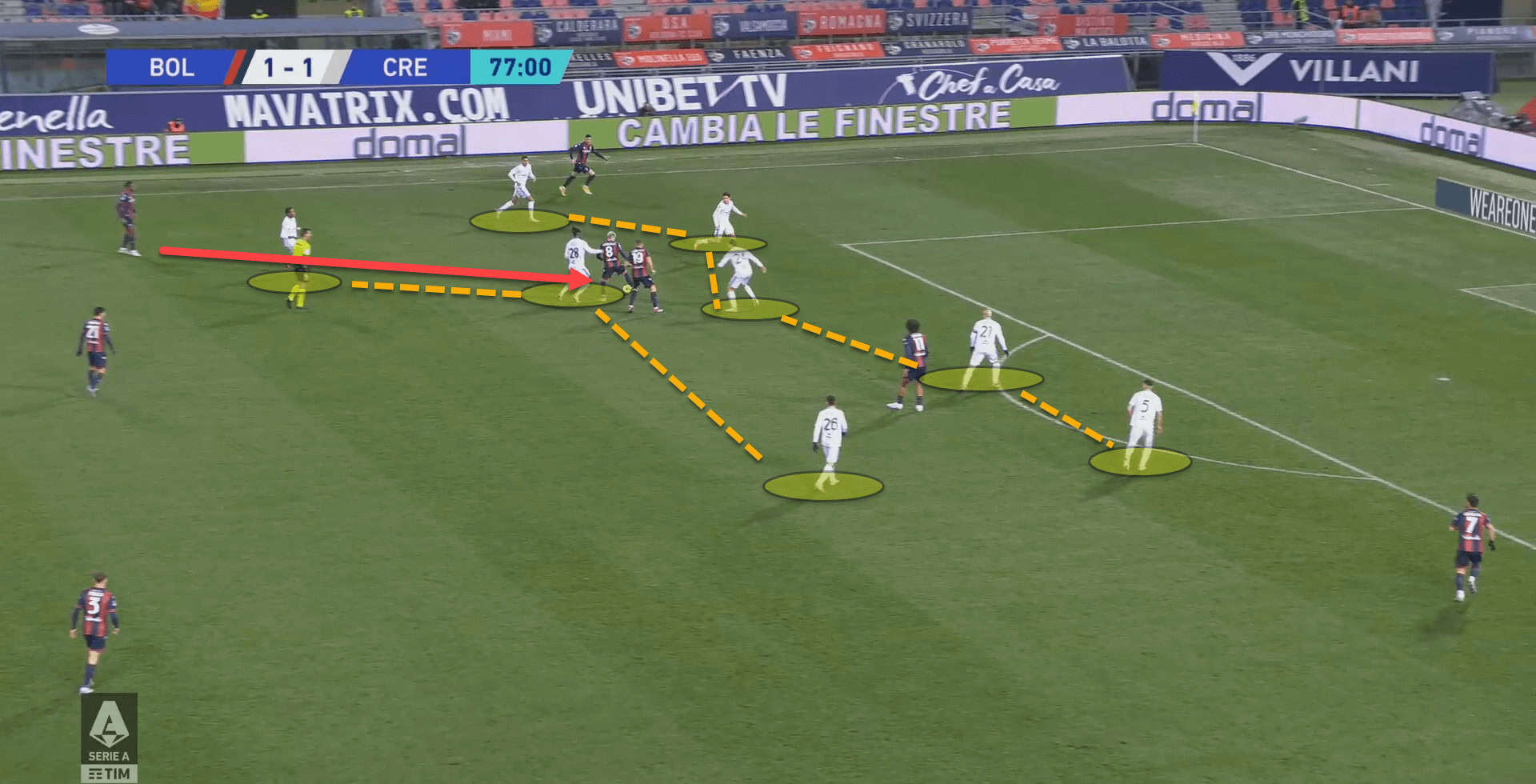
Bologna were finding it far too easy to find their attacking players between the lines of the opposition. Teams always want to reach players in these areas because it is where the best chances can be created.
Cremonese don’t close these spaces off well enough and it can be too simplistic for opponents to pass to an attacker between the lines who can turn, face forward and create a chance or get a shot away.
In this example, Bologna’s attacking midfielder managed to find room outside the box to hit a shot which narrowly trickled wide but could have easily led to Thiago Motta’s team taking the lead.
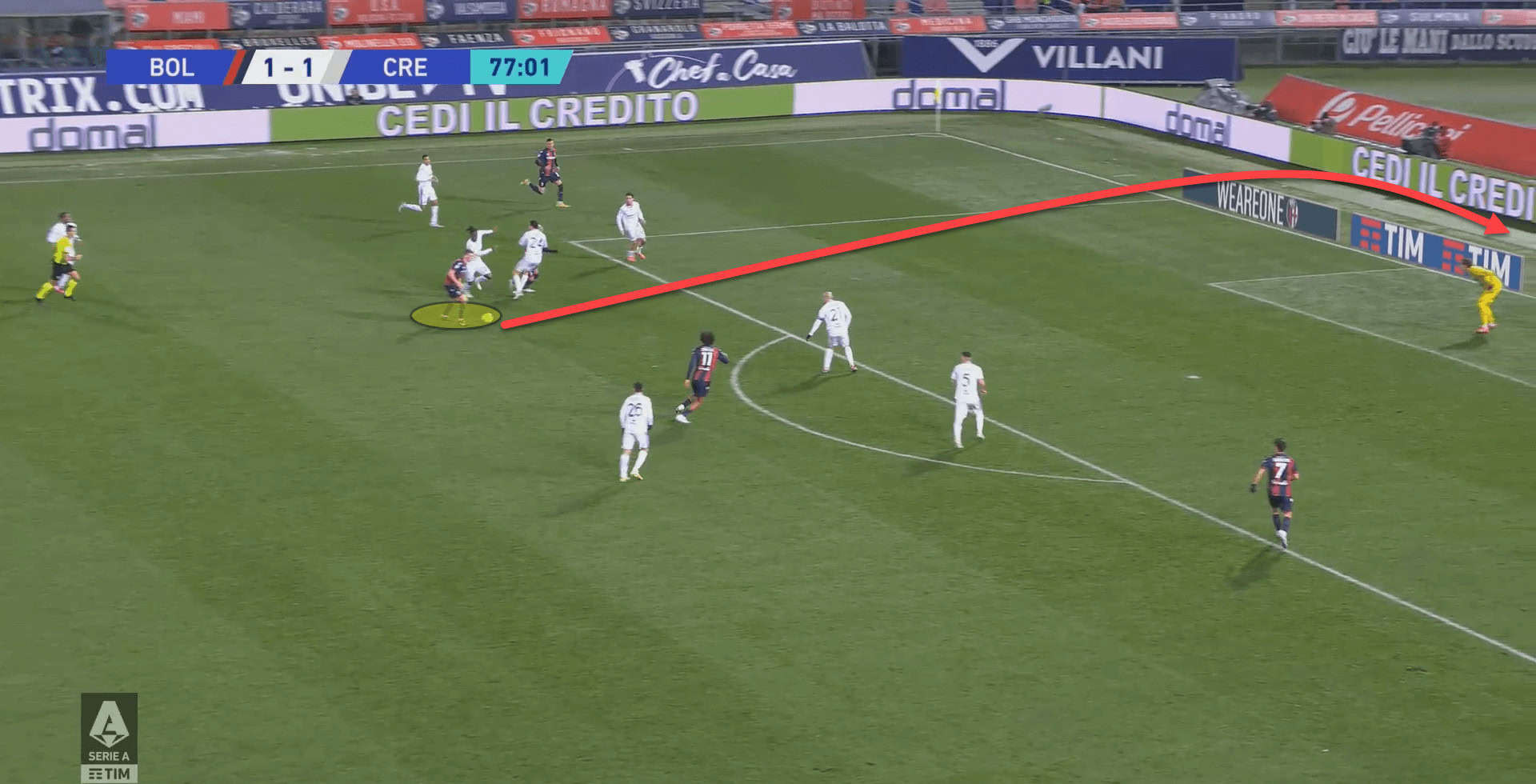
Adding all of these deficiencies up, Cremonese have faced an xG against of 45.5 this season in Serie A which is the second-worst in the league while opponents have bagged 40 of these. What’s even worse is that Cremonese’s goalkeepers have prevented 10.5 goals too, meaning the number of goals they have conceded this season could be a lot higher.
There is no quick fix. Cremonese need to make wholesale improvements to their defending as a unit as well as rectifying individual errors. With less than half a season left, these changes need to come thick and fast.
Defending is an art, but Cremonese’s art is equivalent to a child drawing on a newly-painted wall with a permanent marker.
Struggling in transition
Another major factor behind Cremonese’s inability to claim a single league win this season is because of their over-reliability on counterattacks and their struggles to defend transitions too.
Cremonese hold very little of the ball on average per match. The average is around 44 percent, but this drops even further into the 30s when facing high-quality possession-based sides.
When defending deep, the Grigiorossi sit in a 5-3-2 shape as has already been discussed. However, the centre-forwards also drop back when Cremonese sit in a low block, meaning the entire team is way inside their own half.
This causes a struggle during counterattacks as it is really difficult to reach the opposition’s goal from inside your own half in the modern game due to the maturity and development of rest defence structures.
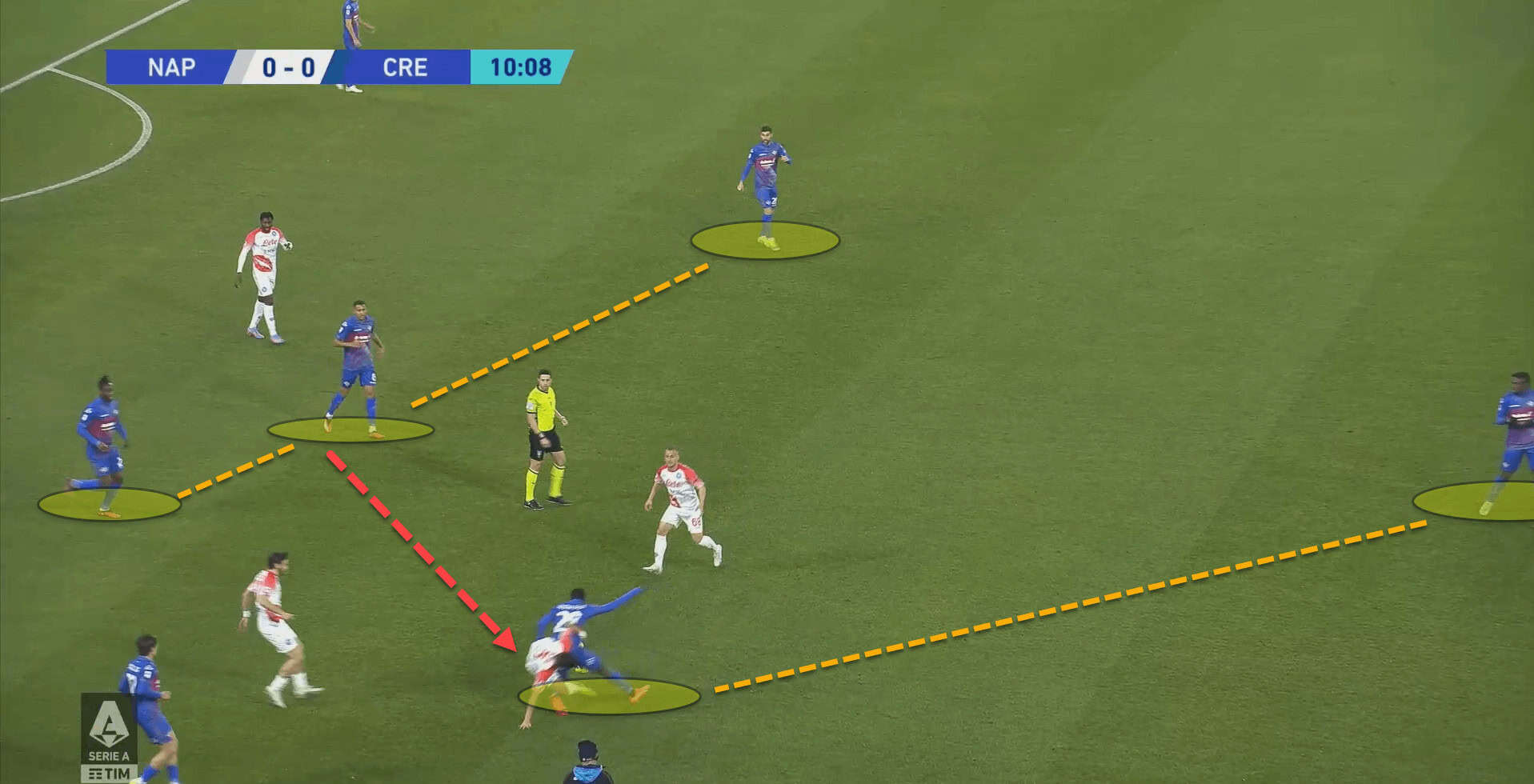
Here, Cremonse won the ball back in their 5-3-2 shape and it was played straight to the feet of the dropping centre-forward.
The striker is being hassled and tugged on by the Napoli defender who jumped him from behind. Napoli’s backline is exposed but Cremonese are not able to form a meaningful counterattack out of a low block state and a foul is drawn in the end which allows the hosts to regroup in their shape.
Many coaches such as José Mourinho and Diego Simeone prefer to defend in a mid-block state for as long as possible. Mid-blocks are not too high up the pitch that the backline are susceptible to balls in behind but is not deep enough that counterattacks fizzle out too quickly. They provide a nice middle ground, but Cremonese have not reached this safe haven and so are swimming in shark-infested waters.
Furthermore, the side are not only struggling to attack on the break but also to defend. Once again, there is a clear lapse in the basic understanding of the principles of defending.
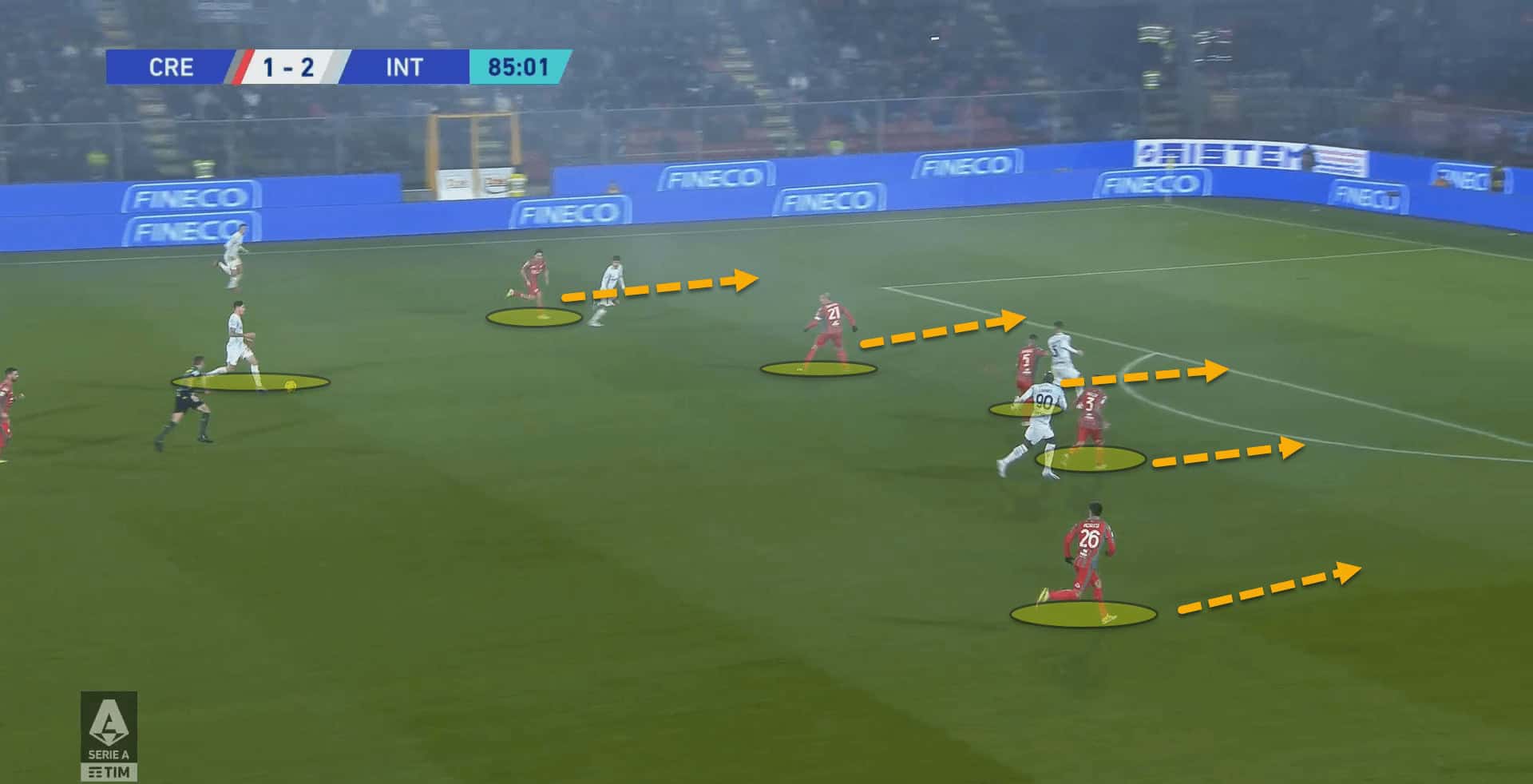
Quite often, when caught on the break, Cremonese’s backline have a painful habit of backing off towards their own goal to curtail the amount of space between themselves and the goalkeeper.
This is the right idea. However, they always seem to forget to send a player out to challenge the ball carrier who is baring down on goal completely unscathed.
In the previous image, Cremonese’s defenders are dropping off and dropping off but not one leaves the defensive line to apply pressure to the most dangerous player – the one with the ball.
What needs to happen is that one steps out while the others drop off and push closer together to close the centre. The best way to stifle a dangerous transition is by shuttling the play out wide where the attack can be dealt with further.
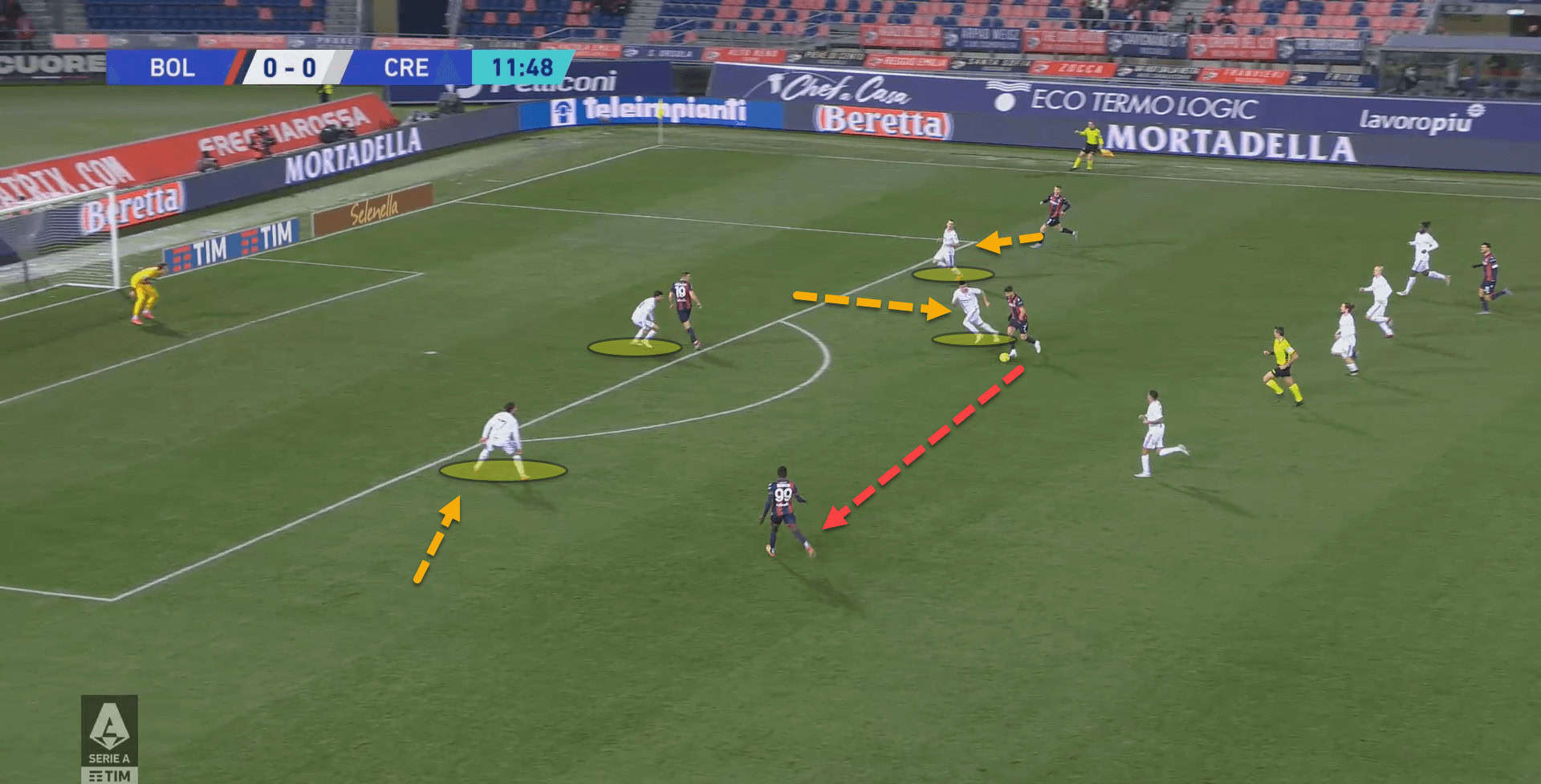
Here, Cremonese did really well to prevent Bologna from scoring in a dangerous position. One centre-back stepped out to challenge the ball carrier while the rest covered for him by squeezing the line closer together.
The only passing lanes available were out wide which is where the counterattack was dealt with by the covering defender winning their 1v1 duel.
Unfortunately, this has been merely a rarity for the winless Serie A minnows.
Conclusion
Cremonese are still the only side in Europe’s top five leagues to have failed to win a single game in the 2022/23 season.
The Lombardy-based club have drawn eight times and so were close on a few occasions where just the one goal was the decider between heaven, hell, or purgatory but a lacklustre forward line mixed with defending that would make Maldini physically vomit are set to condemn the Grigiorossi to relegation on their return to the promised land after a 26-year wait.

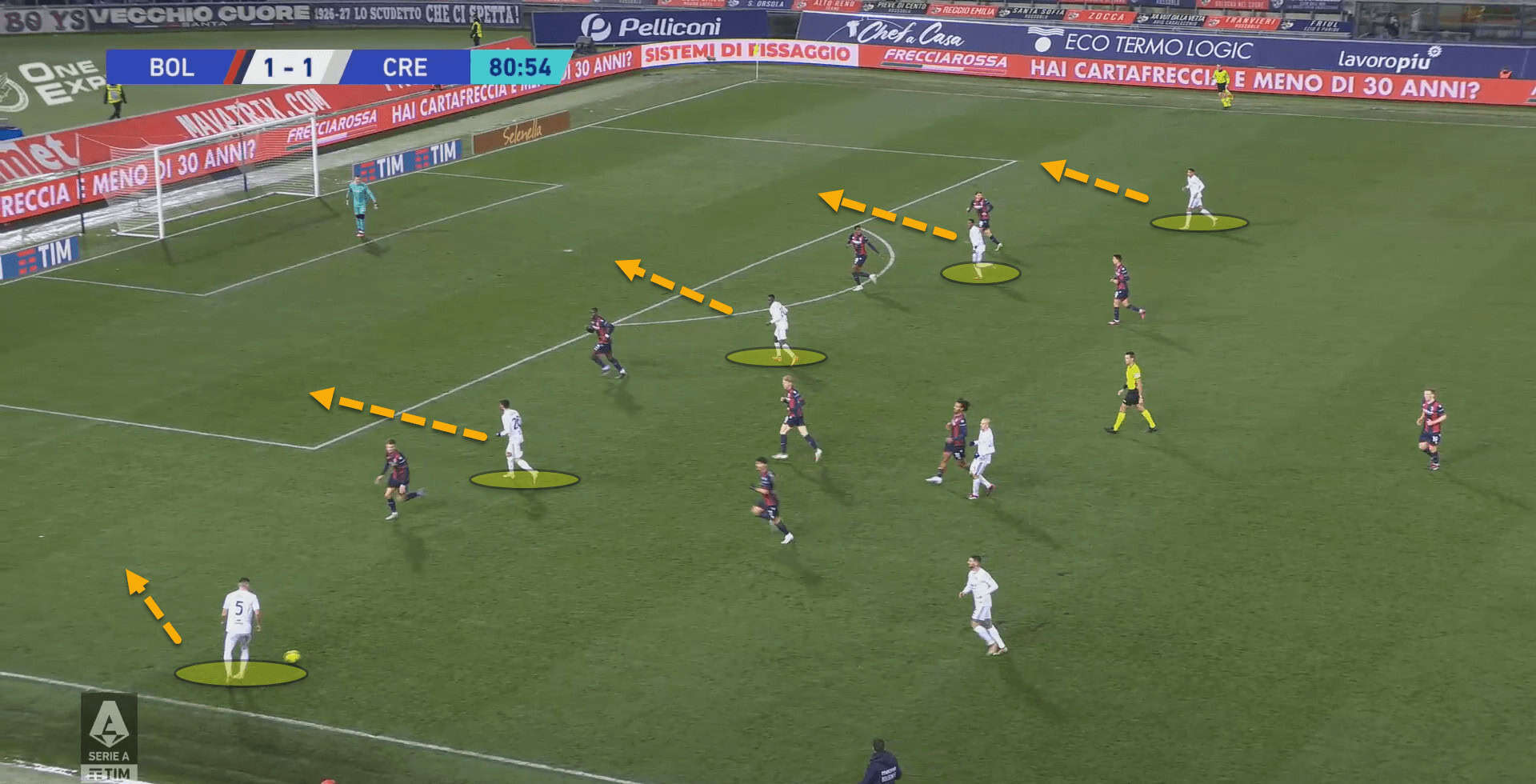




Comments